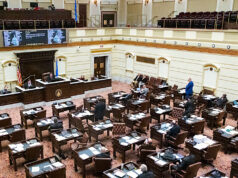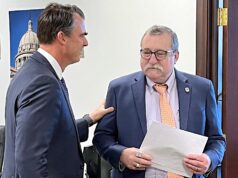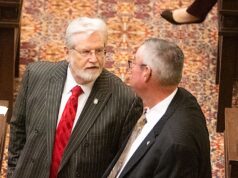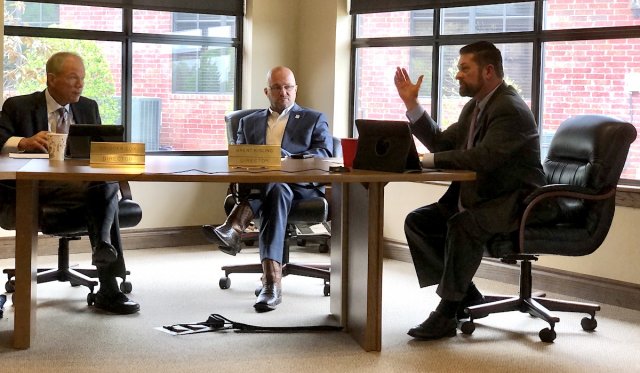
After the Oklahoma Development Finance Authority and the Oklahoma Industrial Finance Authority adjourned their meetings this morning, the agencies’ president, Mike Davis, needed to head back to his desk quickly. The ODFA was “in the market” selling State Regents for Higher Education master lease real property bonds, and Davis told his board of state bankers that “it’s over-subscribed three times.”
“We’re selling $45 million in bonds, but there are orders for more than $150 million,” Davis said after the meeting. “It’s a negotiated sale, so we go back and find out who wants them more. It’s excellent.”
Higher education
bond detailsThe $45 million in ODFA bonds in the market today involve the refinancing of existing debt in Oklahoma’s higher education system. Of that amount, about $35 million is for the Oklahoma State University Center for Health Sciences in Tulsa. The refinancing will result in savings and reinvestment opportunities, according to an OSU spokesperson.
That excellent bond market — which has been helped by S&P Global’s recent affirmation of the Oklahoma bond rating as AA and its boost of the state’s outlook to “stable” — could help the ODFA in its newest and perhaps most complicated project: issuing and selling up to $4.5 billion in bonds to protect utility ratepayers from exorbitant bills racked up during the February winter storm.
“The four days in February — Feb. 15 through the 19th — will live in infamy,” Davis said. “We are now just two and a half weeks into being aware that we are the provider of the legislative solution for this problem of the high fuel costs. I call it utility ratepayer relief. What it is is utility securitization.”
Davis, who has experience with asset-backed financing from his time at the Oklahoma Student Loan Authority, called the Legislature’s utility securitization plan “complicated.” Lawmakers announced their plan April 12, and Gov. Kevin Stitt signed SB 1049 and SB 1050 on April 23.
“We typically do municipal finance here. This utility securitization (program) is a unique marriage of asset-backed securitization financing married to the municipal model,” Davis said. “We’re not the first state to do this. Other states have done it. We are early on in this process. We are working very closely with the State Bond Advisor’s Office. We’re working very closely with the Oklahoma Corporation Commission, with the AG’s Office, and we’re reaching out and having conversations with industry leaders, folks that have done these types of securitization in other states.”
Davis said he and his staff are also meeting with specialized bond counsel, consultants and the nation’s lead underwriter in the limited world of ratepayer debt securitization.
“(We are) basically educating ourselves and making sure that we understand the enacting legislation that we passed, which is just a little bit different than all other states that have done this. It creates some wrinkles. That working group is stood up, and we are all working together to try to figure out how to make it work,” he said. “As I go into it, I look at it this way. My aim is to protect the authorities. My aim is to keep you guys abreast of what is going on so you don’t get blindsided by constituents in your districts. We will execute well. We will figure this out. It’s going to be nice to be part of the solution that is going to help a lot of Oklahoma citizens and a lot of Oklahoma businesses. This is touching everybody.”
During their April 12 press conference, state legislators and the Oklahoma Corporation Commission’s public utility division director, Brandy Wreath, explained how residential customers around the state who typically pay about $100 for heating costs in a normal February might see an average monthly gas bill of almost $2,000 for several months if this February’s historic spike in wholesale gas prices was passed “through traditional regulatory treatment” under a “fuel adjustment clause.”
The impact on many local power authorities would be even more significant if securitization were not allowed, state leaders said.
“They need a lifeline and the state is providing that because we are in a desperate need,” Mike Fina, executive director of the Oklahoma Municipal League, said April 12. “We are at a point where some of these bills are exceeding some of these small communities’ annual budget.”
Other entities, such as Oklahoma hospitals and schools, also racked up shocking utility bills, although it’s unclear how many of those entities will be able to securitize their debt through this new state program.
Likewise, the ODFA, which is allowed to charge an administrative fee for issuing the bonds, does not yet know how many regulated public utilities or unregulated municipal power authorities may participate in the new securitization effort. The regulated entities — such as OG&E, Public Service Company of Oklahoma, Oklahoma Natural Gas and others — must present their choices and proposals to the Oklahoma Corporation Commission.
“Is there a chance that we go through this whole process and nobody takes advantage of this securitization program?” asked ODFA ex-officio board member and Oklahoma Department of Commerce executive director Brent Kisling.
Davis noted that the program is optional, unless the Corporation Commission directs a regulated utility to participate.
“I think the chance no one takes advantage of this is 0. In fact, the Oklahoma Corporation Commission, I think, has got their first case filed,” Davis said. “So there’s one here in the pipeline. I have not had conversations with all of the utilities. Just from what I’ve read, I think they’ve been a little non-committal, but I think I might be too if, two and a half weeks in, (I was asking) what does it look like?”
Davis noted that he and his staff have also had a steep learning curve about the Legislature’s securitization directive.
“Monday afternoon, after the (April 12) press conference, that’s when we found out that we were part of the solution. But we will stand up and serve,” he said. “I’ve had several industries and manufacturers who have reached out to me. It’s unconscionable the increase that they’re seeing (in utility bills). This relief is desperately needed. We are actively working on it. There will be more updates as we move forward.”
After Wednesday’s meeting, Davis said it was too early to know when bonds will be issued, but that it will take more than a couple of months.
“This will take some time,” he said. “The bonds will be issued as soon as practicable.”
He noted that the bond market’s current strength — as evidenced by today’s over-subscription on the higher education bonds — should help with the utility ratepayer securitization program.
“It’s a great market, and that will be beneficial,” Davis said. “That will help to lower the interest cost associated with selling those bonds when we get there.”
Follow @NonDocMedia on:
‘Innovation expansion’ program launched
The ODFA is also moving forward in assisting with a new effort called the Oklahoma Innovation Expansion Program, which will make $10 million available to qualifying manufacturers across the state. The OIEP was created based on the success of the federally funded Oklahoma Bounce Back Assistance Program, which was intended to encourage companies to make new capital investments that could lead to new product development or capacity increases for existing Oklahoma companies.
Jeremy Stoner, a senior vice president for ODFA, told board members that the OIEP application window opened Monday and that, by 5 p.m. Tuesday, the program had 32 applications. ODFA and the Oklahoma Department of Commerce are co-administering the effort.
“Those companies have 2,051 existing jobs,” Stoner said, noting that qualifying companies must have at least $625,000 minimum payroll per year. “We are looking for for-profit existing companies. This really isn’t about creating new businesses (…) this is about taking care of our own.”
The OIEP application deadline is May 7.
Davis said that, in nine months, the Oklahoma Bounce Back Assistance Program has already made 424 payments totaling about $5.7 million of the $7.4 million available.
Background on ODFA, OIFA
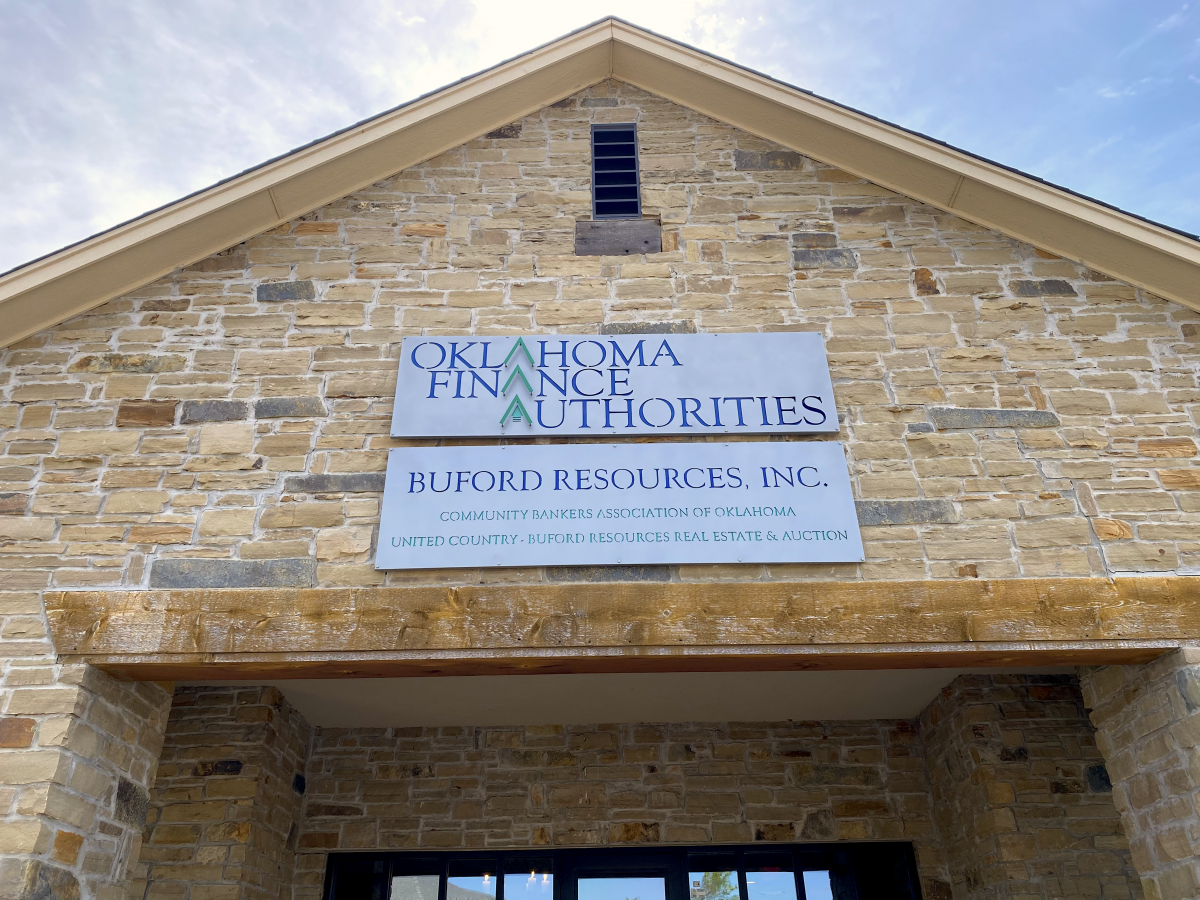
Davis took time after Wednesday’s meeting to explain the history of the two organizations he operates. In 1959, the OIFA was codified in the Oklahoma Constitution by a vote of the people. In 1974, the Legislature statutorily created the ODFA. The seven-member board governing both entities requires one representative in the banking industry from each of the state’s congressional districts as they stood in 1959, as well as one at-large member. Members serve six-year terms, and Chairman Roger Wagner is rolling off of the board this year.
“OIFA issues general obligation debt of the state of Oklahoma. The proceeds of the sale of those bonds go into a revolving loan fund,” Davis said. “Then we are able to utilize those and do land, building and equipment lending to for-profit businesses outside of agricultural production and energy and gas exploration.”
He said OIFA’s purpose in 1959 “was to help diversify the economy of the state and grow payrolls.”
“[Constitutionally], we could issue up to $90 million,” he said. “Today we have $30 million out, and the maximum loan we can do is $5 million on a single project.”
He said the ODFA is a multi-jurisdictional conduit bond issuer.
“It’s an Oklahoma state beneficiary trust. So what we’re doing is we’re issuing public debt primarily to fund health care, education and state and local government projects,” Davis said. “We do hospitals. The 501c3’s. We do both tax-exempt and taxable financing. At times, we have worked with private companies, and they have been able to take advantage of tax-exempt and tax-advantaged financing where the IRS has identified qualifying costs.”
He said ODFA has assisted with waste management projects in the past, as well as public utility upgrades “like when they were putting scrubbers on coal-burning plants.”
“But it’s primarily health care, education and state and local municipal finance,” he said.











